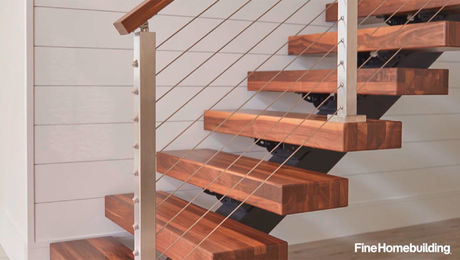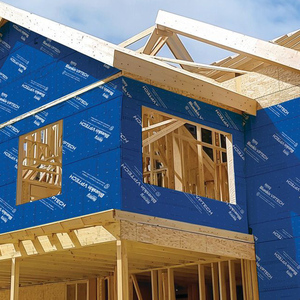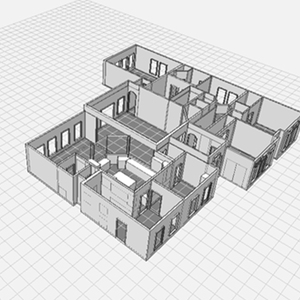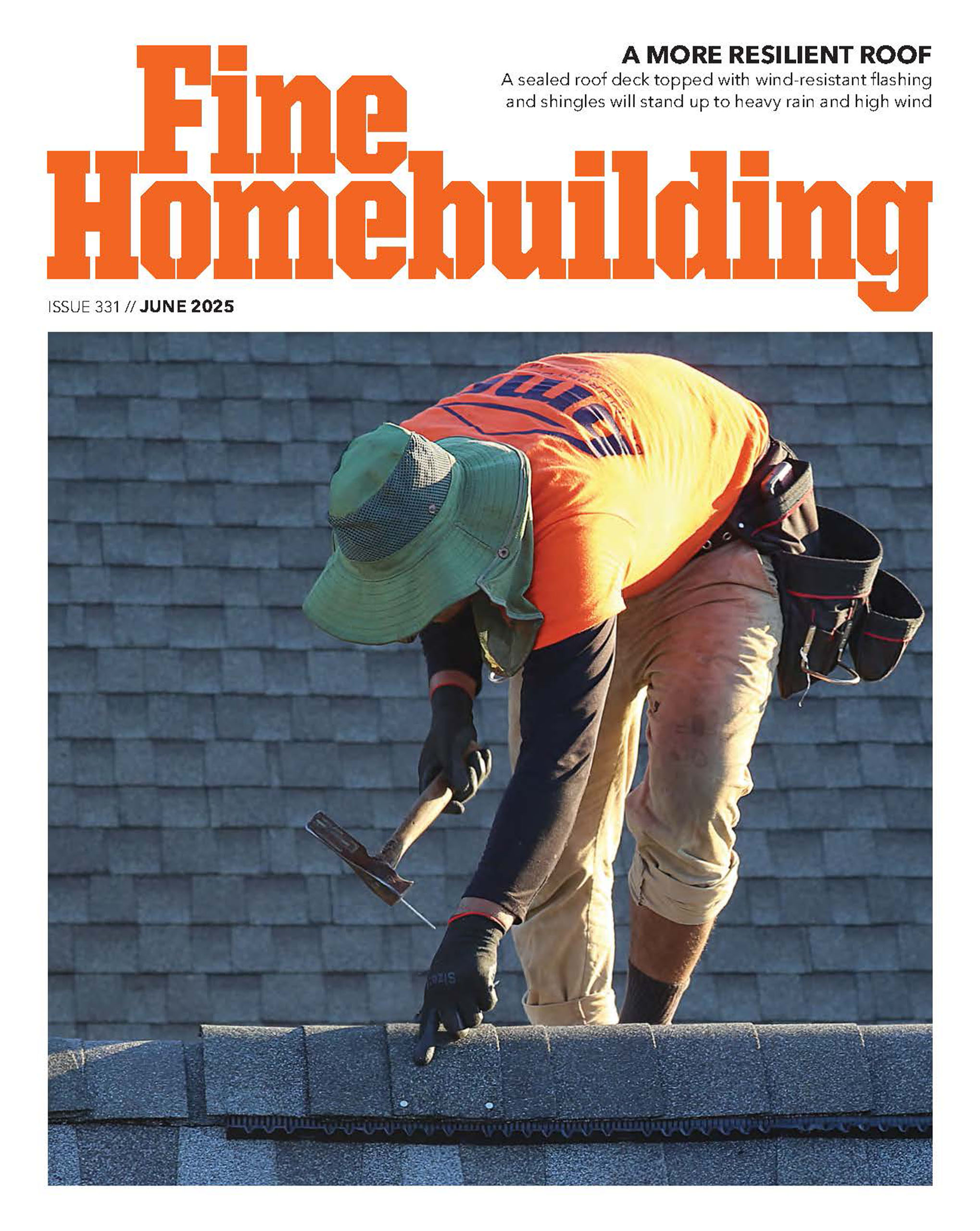Hi,
I’m a homeowner watching the subs erect the concrete forms for the new addition.
I noticed that the forms are being set up off center of the footings, way off center. At on point the edge of the forms is about 1″ in from the edge of the footing.
Is this acceptable? What does code allow? Should I be making a call to my GC?
I looked through my JLC Field Guide, but could not find an answer.
Thanks



















Replies
sounds like someone screwed up big time. I would not except it
In the JLC Field Guide it shows a repair for off center footings. However the illustration shows the foundation wall hanging over the edge of the footing. Am I to infer that at long as it does not hang over the edge of the footing that repair is not needed?JLC Guide shows how to install a supplementary footing next to the footing. It shows how to tie the footings together with epoxy and rebars dowels.It will be interesting to see what the inspector says. Could cost my GC some coin.
There is some play in centering a wall on its footings, but too close to the edge can cause the footing to tip and crack. That will vary with the footing, the load, and the soil. An engineer's report might be worth considering. It might not be a big deal, and it's possible everything is fine. If it isn't, the fix usually isn't outrageously expensive.Andy Engel
Senior editor, Fine Woodworking magazine
An updated profile is a happy profile.
Other people can talk about how to expand the destiny of mankind. I just want to talk about how to fix a motorcycle. I think that what I have to say has more lasting value. --Robert M. Pirsig
None of this matters in geological time.
I wouldn't suspect that this fix would be on the homeowner's bill, would it?
Justin Fink - FHB Editorial
I would not worry about it if any of the folowing
If the stemwall and footing are poured at the same time
Stemwall is less than foot high
Vertical steel is 24" o.c. on tension side
You not in earthquake or tornado country
Ground is rock hard
Building Inspector says OK
Thanks for the advice,I guess I'm going to have to learn to trust my GC, which is not easy for me to do.
And why do you have a difficult time trusting your GC?
We can't see your project from here, can't evaluate the prints or second guess the engineer who drew them or check the measurements of the subs who have done the excavation, poured the footing and who are now erecting the forms. Any one of these could be off.
You shouldn't try to micromanage the project but you should be talking to your GC. I simple question, such as, "Should the stem wall be balanced in the center of the footing?", might be enough to remove your doubts.
Again, you selected the GC. There must be a reason you signed the contract with him/her and parted with your hard-earned money. Let him do his job.
I always worry if the wall and footing are poured at the same time. Sure sign of a hackLignum est bonum.
I remember your rant about monopours, many moons ago. I tend to disagree and I form footing and wall at the same time and pour it all, but that's because I worked a lot in California where a cold joint in the foundation is not appreciated. There are guys I see locally who monopour, and they embed wooden stakes in the bottom of the wall... stakes used to hold the footer forms to the correct spacing. Tacky. At least use the metal cleats if you're going to do that.
Edited 9/21/2005 10:44 pm ET by davidmeiland
Wouldn't you rather have a nice stable flat footing to snap lines on so your wall will stay where you intended it to? Yes it is possible to get accurate work from monopour but the extra effort required (a) isn't taken by most people, and (b) ends up costing the same as doing it in 2 pours anyway.
BC is in the same Cascadia fault zone as extends thru Cali, probably more susceptible to a big one soonish because there hasn been so little activity for so long. Engineers here are just fine with keyway and rebar tying wall and footing together.
Regards,
Wally
Lignum est bonum.
Missing in this discussion so far is why the builder did not get the footing centered under the foundation. How hard is it to lay out the foundation, then move the string out 4 or 6 Inches? The long-term perfomance of this footing depends on the soil conditions. On the right soil, you could build the foundation directly on the soil and never have a problem. But what if plastic soil conditions develop? We use footings to spread the load. The footing functions like a snowshoe. If your foot is in the center of the snowshoe, it works; but, if you put your weight on the edge of the snowshoe, it tips. This foundation may never fail. My point here is that it would be less likely to fail if the footing had been centered under it.
The footing functions like a snowshoe. If your foot is in the center of the snowshoe, it works; but, if you put your weight on the edge of the snowshoe, it tips.
Or not (from a standard engineering book):PAHS Designer/Builder- Bury it!
its not a big deal. the bldg weight is on the stem wall. then it multiplyied to the footing. the wider the footing the less weight on the soil bearing. the footer not going to tip over. if you have a 1000 lbs per lineral foot on a stem wall and a footer 2 foot wide then the weight is reduce to 500 lbs pe lineral foot. It doesnt matter where it sit on the footing to reduce the load. Now if you was building up with concrete like a tower or retaining wall with a wind resistance yes , it would matter. But most houses are dead loads. Its no big deal. He had to move the stem wall to square the house. its common, in fact mine is the same way.
Thanks guys,I decided not to say anything to my GC. I would love to just trust my GC, but he has given me reason not to. Let's leave it at that.
The footing is one issue.The location of the foundation walls are another.I would either varifiy that the walls are in the right position or mention this to the GC so that he can verify it.You don't know which was miss placed.
That's what a surveyor is for. Many banks require an as built survey, which, generally is done anytime after the foundaton is built. If an as-built survey is not required, it never hurts to spend about 20 minutes with a tape measure or 2, the plans, and the new foundation.
You're just at the beginning of your project and you say you don't trust your GC AND you are NOT going to talk to him about your concerns???
How about just handing him the rest of your checkbook, your savings account and the keys to your safe deposit box and your house and cars.
How can you admit something like that on a public forum that your GC may read?
How can you admit something like that and look yourself in the face in the mirror and face your family?
What else are you going to overlook that might cause your house to fall apart or burn down?
Guys,I am talking to my contractor about my concerns. Problem is he is not listening.A neighbor across the street built an addition. The city inspector was very tough on them regarding shoring up the existing foundation. This caused a big delay in their schedule.I related this story to my contractor, prior to construction beginning. Told him he might what to get a structural engineer to sign off on foundation details relating to the existing foundation that is to be excavated. He didn't. I figured he knew what he was doing. Had to get a engineer out after the failed inspection. 4 week delay.By discussing this issue on this forum I'm trying to get an idea whether or not I have a valid concern with the foundation. It appears I don't unless the City Inspector does not like it. I will be out in the morning taking measurements to make sure dimensions of the foundation are accurate. At this point my rational is to trust the GC, but also to verify things that I can. Seems like a rational approach, no.
You're waffling.
The issue is not the foundation, it's your trust - or lack of trust - in your GC.
If the guy is not sensitive to your concerns and pays no attention to your information what do you expect when you get the structure out of the ground?
Did you have to pay extra for the engineering service or did your GC pick up the tab? I wouldn't have to guess. Even if I knew the answer I'm required to have stamped documents on anything more than a dog house. Do you?
How is your stem wall going to be attached to the footing? You know it's going to be a cold joint. Is there a keyway or are there embedded rebar? Do you have the knowlege to check the dimensions against the plans? Can you verify the forms, hence the stem wall, are square, plumb? How about proper height/depth? Do you have the plans?
If you find a discrepancy will your GC listen? Will he verify? Will he walk? Are you prepared for that?
Mike,
Brownbagg is right (of course he is, it's what he does for a living). <G>
You really don't need to worry a bit. As long as the subgrade is native or properly compacted, and the wall is somewhere on the footing, you shouldn't have a problem.
Typically you'll see a couple pieces of #4 rebar horizontal in the footing and some verticals. Unless something else goes radically wrong, you cannot generate enough stress to damage the footing or the stemwall.
If it helps allay your concern, I have poured footings 5' wide and intentionally put the wall on the outside edge. It's called an overturn footing, it provides moment resistance to tall retaining walls.
As a matter of fact, if you have poured stemwalls and the right horizontal and vertical steel in the wall, you can occasionaly miss the footings completely (for the reasons that Brownbagg already explained)and it really doesn't make a bit of difference.
The trim carpenters ought to howl at that one. <G>
Sorry guys, it's just arithmetic.
Without seeing the design and seeing how much of the footing is off kilter it's hard to say, but walls are seldom dead center on the footer and it's usually ok. It would not be ok if the soils are such that the footer is marginal if constructed correctly and the offset is significant.
Personally, I'd document the offset with photos and make an entry in your construction journal in case a great deal of settling happens in that area. If push comes to shove a journal is much more valuable in court than trying to remember specifics from months or years ago.
You do have a construction journal don't you?
Best of luck with your new home,
~D
Yes, I do have a construction journal. Just in case something goes wrong and also so we can look back on the pictures some day and laugh.
Our NC code requires a minimum of a 2" footing projection, sometimes larger depending on several factors. Screw-ups in this area are common - I'm thinking maybe 1 in 10 footer pours. some BIs check footing projections, some don't. It's a hard thing to catch though, because often maybe a footing may have 200 LF, and have 1 2 ft section that is messed up. Attached is a pic of a repair. In this case, I used 18" anchor bolts as that what was laying around... The brick point actually landed 4" or so off the footing. That particular part of the footing only had to support an attached shed so I didn't think twice about it. I just used a slurry of mortar to hold the bolts in place. The bolts fit tight and had to be driven in.
The good news is that from the way you describe it, your situation could be easily remedied (if necessary) anytime before backfill.
Prob doesn't help you, but I understand not trusting the GC. In my neck of the woods, there are no GC's who really know the field- not that they are cheats or hacks, they really just don't have the knowledge, and trust their subs. I worked for a few years in the trades, and my "green" questions about whether so and so was correct were met with scorn, when in fact they warranted attention. I haven't met a contractor or sub yet whom I thought really knew their trade (except for some masons- for some reason they are always old-timers, even in the burbs). Some things you can't do yourself, and you need a GC or subs- but you end up watching them like a hawk and worrying like you are. Good luck!
Sometimes walls and footings are engineered off centre. I don't know if that is the case at your site. Reasons include:
If the wall and footing are tied together properly there should be no reason for the foundation's load bearing capacity to be compromised.
Wally
I've gotta side with Ralph on this one. Your relationship with the contractor is in trouble, and you need to be the one to address it. If it's going south already, nothing but the footer poured, wait until they're trimming out, everyone will be carrying weapons on the job by then, including you.
I would sit him down and talk. Tell him you need him to deal with your concerns. It's a very bad sign that he's already ignoring you, and you need to straighten him out. It sounds like you are being tested. Cave in and he will walk all over you. Time to insist on communication and service, or get someone else.
You should absolutely inspect the stemwall forms carefully before they are poured. You need a helper, and ideally a laser level, to do it accurately. The forms should be level, of course. Use string lines and verify that all of the walls are straight. Check that those same strings are parallel and perpendicular to each other, and to the existing building lines. Check the diagonals of each rectangle or square and make sure they match when measured both ways.
Check where the rebar is set and make sure that it has the appropriate clearances to grade and to the forms. Are they hanging anchor bolts before the pour (they should, IMO) or are they wet setting them? Wet setting is for guys who can't bother to prepare for a pour.
Are there blockouts for utilities to pass through? Are there foundation vents, and are they installed level and far enough from corners? Are the forms well braced or are they gonna move during the pour, creating a situation where the crew has no choice but to leave an ugly blowout?
While they are pouring, the concrete should be fairly stiff, enough to require tamping with sticks or shovels, and they should use a vibrator. Concrete that's sloppy wet is a poor product.
Anyway, it's time to jump on this guy.
MikeK,
My .02 from my experience on a recent addition. Ask, measure yourself, take pictures, and make him understand early on that you'll only accept work that's done right. Here's just a few of the probles I caught on my addition:
1) Door opening roughed in where screen would attach in the middle of the 6 foot opening! Luckily I caught it early and they hadn't tied in the other side of the opening to the house.
2) concrete block footer off by 8" from one side to the other. Had to build a form and fill with concrete to correct.
3) Patio pavers installed using the wrong pattern. Had to take up 450sf of pavers and put them down again.
4) 2 door openings cut in the wrong place even after I marked the centerline of both on the drywall.
5) wall framed out at the wrong height for window to be flush with granite countertop. Luckily, I caught that one early.
6) aluminum doors with impact glass installed out of level, with bent hinges, you name it.... Took me a while to get the door manufacturer out, but once they came out, took them 3 hours to correct problems on the 6 doors.
7) too many drywall / paint issues to remember. Blue painters tape was used to illustrate all the areas... Got his attention.
8) Door trim cut back an inch above the new floor tile - all doors had to be retrimmed.
Anyway, you get the point. Only you can ensure you get what you pay for. I must say that after pointing out the first few problems, my GC didn't argue about fixing any of it. That didn't reduce the frustration of having to point it out and deal with the schedule delays, but at least when the job was complete, we were happy with the outcome.
Good Luck,
Terry
Like I said it's pretty common. There is a builder building next to me - every time I talk to him about subs it always "OH- my siding guy is much cheaper than yours" or "My concrete guy is $1 a sq foot cheaper than yours"... Or "Your footer guy charged HOW much?" He had 4 footers (4 houses) poured a week ago. Here are pics from 2 of them... The way our surveyors set the foundation corners (brick points) is to nail down a piece of plastic surveyor ribbon - look for the pink spots in the pics...
They don't even form them, eh? Just throw the mud in a trench. Any rebar in there?
I've never even seen formed footers - except on comercial jobs when they excavate out, build a pad, and then form up from there. The soil around here is not granular at all. You can usually dig a ditch that is 7' deep and 20" wide - straight down...
Rebar is not necessary when you have hard ground. If the soil is questionable, then rebar is added. When I built my house, I did install rebar - in retrospect - it was just a waste of money.